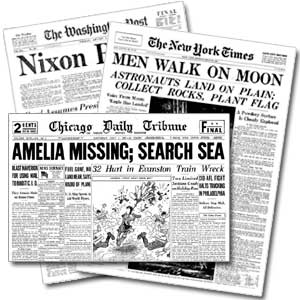There is a saying that it’s a journalist’s job to write “the first rough draft of history.” Nowadays, many of these drafts are blasted out in the form of tweets, blogs, and Facebook updates. The Internet and social media are revolutionizing the art of reporting. They are also forcing newspapers, news networks and other media companies to engage in a radical rethinking of their business models.
Studiously documenting all these changes is the Newseum, a 250,000-square-foot museum in our nation’s capital that has cataloged the highlights of 500 years of news history.
Just last year, the Newseum – which already had 14 galleries – created a 15th, the HP New Media Gallery, which documents the changing media landscape in the age of Twitter, Facebook and YouTube.
In an interview with the Collaborative Services blog, Jonathan Thompson, the Newseum’s media-relations manager, talks about the Newseum’s efforts to track and document these rapidly changing dynamics.“The news industry has had to adapt to the speed of news just like everyone else.”
The Newseum’s most popular galleries are dedicated to coverage of 9/11 and Pulitzer Prize photographs, and it is planning a new exhibit to mark the 50th anniversary of the assassination of President John F. Kennedy.
For those of us with a bias toward print journalism, Thompson highlights one particular exhibit that really caught our attention: a “Dunk the News Anchor” game.
Although the methods of reporting are evolving as rapidly as the latest social-networking tools, the goal of the best journalists is the same now as it was back in the days of the ink-dipped quill pen: Finding the truth. We welcome his thoughts.
– – –
The Newseum is a museum dedicated to the news. Why is it so important to preserve the news?
It’s important to preserve the news because news is the first rough draft of history. News from the front lines, recorded by an eyewitness is critical to our understanding of the past and can help guide us in the future. The Newseum’s News History Gallery on the 5th level of the museum spotlights significant moments in human history going back more than 500 years.
The Pulitzer Prize Photographs Gallery is my personal favorite because the images on display there capture the power of still, mostly black and white photography. The Newseum is unique in that while some exhibits feature the latest technology, others like the Pulitzer Gallery show a simpler version of how news is made.
The outside of the Newseum’s building is in a way a monument to the First Amendment. The building features a 74-foot-high marble panel that is etched with the 45 words that make up the First Amendment. Why was the decision made to add these words to the building’s exterior?
The Newseum’s mission is the following: “The Newseum educates the public about the value of a free press in a free society and tells the stories of the world’s important events in unique and engaging ways.” The First Amendment tablet is a reminder to both ends of Pennsylvania Avenue of the laws they cannot make.
The Newseum is also home to the Journalists Memorial that pays tribute to journalists and photographers who have died while reporting the news. How did this memorial come to be?
The Newseum dedicated its new Journalists Memorial on April 4, 2008, seven days before the Newseum’s Grand Opening. A previous memorial had been displayed in Freedom Park at the Newseum’s former site in Arlington, Va. The Journalists Memorial gallery also features hundreds of photographs of the honored journalists as well as kiosks where information on each person can be accessed. The online Journalists Memorial database can be accessed at this link: Journalists Memorial. The memorial honors newspeople who died or were killed while in the pursuit of news.
What do you believe has been the most significant news story of our time?
It’s impossible to say. Each piece of news impacts people in a different way and at different times during their lives.
What can the public look forward to at the Newseum in 2013?
On April 12, 2013, the Newseum will mark the 50th anniversary of the assassination of John F. Kennedy with two new exhibits and an original documentary chronicling the presidency, family life and death of America’s 35th president. The JFK exhibits will feature rarely seen artifacts and photos, and will explore journalists’ words and images that are so powerful they still resonate with us.
- “Creating Camelot: The Kennedy Photography of Jacques Lowe” features intimate images of Kennedy and his family taken by Jacques Lowe, Kennedy’s personal photographer.
- “Three Shots Were Fired” tells the dramatic story of the news media’s reporting of the tragedy through powerful artifacts, images and historic headlines.
- “A Thousand Days,” a Newseum-produced film shown on a 100-foot-wide video screen, uses original footage and interviews to examine Kennedy’s presidency and family life in the White House.
- The first UPI bulletin reporting that “three shots were fired” at the president’s motorcade.
- The service revolver carried by Clint Hill, the Secret Service agent who leapt aboard the presidential limousine after the shots were fired.
- News cameras, notebooks and press passes used by reporters to cover the story.
- A typewriter, stopwatch and pipe used by Walter Cronkite.
- Jacqueline Kennedy’s personal schedule for Nov. 21–22, 1963, marked in red pen with her handwritten notes.
- A drum used in Kennedy’s funeral procession in Washington.
- Historic newspaper front pages and original magazines that chronicled the story of the Kennedy presidency.









Recent Comments